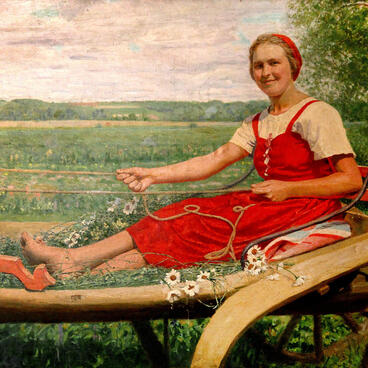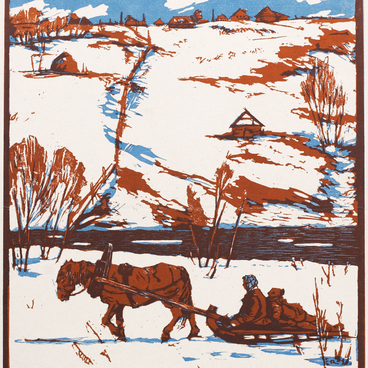The artist Stanislav Vikharev is best known for his graphic sheets featuring Leningrad cityscapes. However, his oeuvre encompasses a wider range of themes and subjects. The Irbit Museum of Fine Arts houses his linocut “Buoy Keeper” from his series “Volga Residents”.
The Volga region encompasses a significant area along the Volga River. Like any major navigable waterway, the Volga required some form of navigation aid to ensure the safe passage of ships. This is what the buoys were used for. A buoy is a floating device that marks navigational hazards along the ship’s route or indicates the fairway — a safe route through shallow areas that is deep enough to navigate. Initially, buoys were made of wood. To keep them stationary, they can be anchored. Before winter, buoys were removed as otherwise they could be swept away by spring floods or damaged by ice. In autumn, after the navigation season ended, they were removed and stored until spring. They were then reinstalled after the ice had melted. During the day, buoys were clearly visible. However, at night or during a fog, it would be difficult to see them without a light inside them. The light could easily go out and needed to be relit. There was a kerosene lamp inside the buoy which could be extinguished due to rain, strong winds, or other weather conditions.
A buoy keeper was assigned to each section of the river. Every morning and evening, they would approach the buoys in a boat. In the evening, they would pour kerosene into the lamp and light it. In the morning, the lamp had to be extinguished. Each keeper was responsible for several dozen buoys. Buoy keepers worked day and night because, in bad weather, the lamps had to be lit even during the day. The hardest time for buoy keepers was spring and autumn when it rained, there were frosts at night, and fog during the day. In the mid-1950s, batteries were installed inside wooden buoys. Later, metal buoys began to be used. The profession of a buoy keeper faded into the past.
In this graphic sheet, Stanislav Vikharev depicted a woman representing this obsolete profession, standing in a boat and holding a kerosene lamp. She looks into the distance, checking whether the lights in the buoys are still lit. There is another buoy ahead that needs to be lit.


